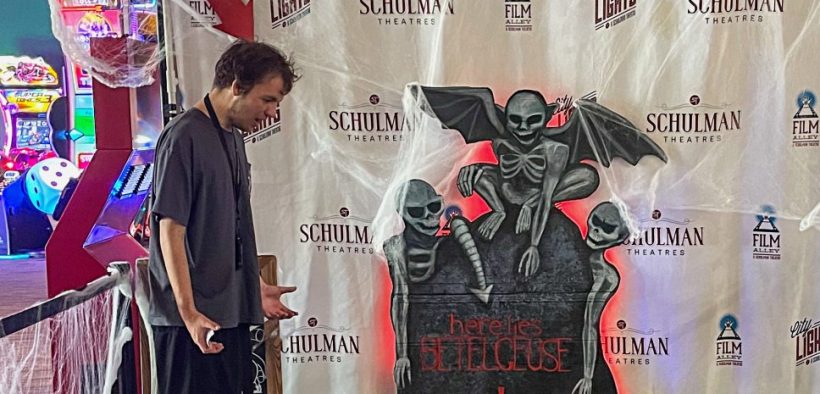Beetlejuice, Beetlejuice Review Review
Share

Beetlejuice, Beetlejuice, Beetlejuice! Practical effects and zany performances shine in the serviceable legacy sequel!
If you’re like me, then your first reaction to the trailer for Beetlejuice 2 was one of incredulity. The slow panning shots of the old, decrepit locations from the first film, overlaid with a slow, serious cover of the film’s classic theme song, before crescendoing with the reappearance of the film’s iconic character—cut to the title—Beetlejuice, Beetlejuice. It’s a trailer style familiar to Star Wars, Top Gun, and Ghostbusters fans. To see Beetlejuice, a film that was always intended as a one-off, become the latest in a string of attempts by Hollywood to create a new franchise was both bleak and a little hilarious.
I’m pleased to report that I believe in giving things a fair shake, so along with a few friends, I attended a matinee of “Beetlejuice 2”. The movie picks up 35 years after the first film ended. The Maitlands have long since departed, and Lydia Deetz (Winona Ryder) has harnessed her abilities into a blossoming Ghost Hunters-esque reality TV show. Her influence has made her something of a town legend, causing a significant rift between Deetz and her teenage daughter, Astrid (Jenna Ortega). A tragedy sends Lydia, Astrid, and Delia Deetz (Catherine O’Hara) back to their home, where a chance encounter leads them on a twisted path involving rogue demons, demonic possessions, sham marriages, ghost cops, and ultimately into the clutches of the Ghost with the Most, Beetlejuice (Michael Keaton).
I’m pretty comfortable saying that this film would not be anywhere near as good if it hadn’t been directed by Tim Burton. Burton is most famous for his gothic horror aesthetic and use of practical effects, which often personify a cartoonishly grotesque world. Think Corpse Bride, Sweeney Todd, and Batman (1989). Over the past fifteen years or so, Burton has largely abandoned this aesthetic in favor of more CGI-based, tentpole films, such as Miss Peregrine’s Home for Peculiar Children, Dumbo, and Alice in Wonderland. In a sense, “Beetlejuice 2” is a return to form for Burton. Not only does it return to a property he last visited in the 1980s, but it is also a return to his macabre, grotesque style and heavy use of practical effects. These effects give the film a sense of life, aesthetics, and identity I haven’t seen in a mainstream sequel in years. Using puppets, hand-built sets, and costumes allows the film to maintain its signature kooky-creepy aesthetic, and is by far the best part of the film. The way the ghosts, ghouls, and goblins are depicted in the Beetlejuice films is unique, as far as I’m aware. In its humor, execution, and aesthetic, the film is essentially a live-action cartoon. And when it embraces that, it is at its most enjoyable.
This cartoonish vibe is perfectly embodied by two of the film’s supporting characters: Wolf Jackson (Willem Dafoe), who plays a movie star-turned-cop ghost, and Delores (Monica Bellucci), Beetlejuice’s scorned, vengeful wife. When the film embraces its status as a live-action, slapstick horror comedy, it is a complete blast.
Where the film fails most severely is its narrative. Credit where credit is due: the film does try very hard to have a beating heart at its center—namely, the relationship between Lydia and Astrid. There’s also an interesting parallel between the first and second films with Lydia and her smarmy, business-savvy partner (Justin Theroux). But the core of the story is definitely between Lydia and Astrid. The film doesn’t really provide enough context for their relationship to make the audience invested, even if they can get past the legacy character not getting along with their child trope. And as much as I love Jenna Ortega, this film wastes her on a character who, by and large, is not that interesting. Astrid spends most of the film being resentful toward her mother, mourning the loss of her father, and resenting her mother for spending more time hunting ghosts than raising her. Unfortunately, screenwriters Miles Miller and Alfred Gough adopt a “tell, not show” approach to their relationship. As such, it’s hard to really get invested, especially when it becomes the focal point of Lydia’s arc. When Lydia’s arc wraps up, the closure is toothless, not impactful, and overdone. I will say there is maybe a 90-second scene toward the end that almost redeems this in a genuinely touching way, and had the screenwriters chosen to play it straight, it would have made a nice ending to the film.
As superb as the direction is, the script is all over the place. The performances here are doing a lot. Ortega is trying her best but doesn’t have much to work with. Ryder, O’Hara, and Keaton are all giving genuinely earnest performances, especially in a movie that’s as silly as this one. Keaton, in particular, does a lot here. Even at 73, his performance is animated, energetic, and well-timed. The film works best when it’s embodying the traits of Keaton’s performance: erratic, buffoonish, and cartoonish. The climax of the film works well, acting as something of a crescendo of lunacy.
Ultimately, “Beetlejuice 2” is a relatively harmless, fun, and enjoyable time at the movies. If you’re looking to laugh, have a good time, and ogle at the visual effects, you’ll have a blast. But if the emotional core is important to you regardless of the genre, you’ll likely find yourself rolling your eyes at the emotional beats between the ghoulish shenanigans.
